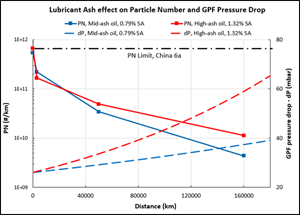Jul 15, 2020
Posted by Keith Howard, Strategic Technology Manager
In order to assess the effects of engine oils on gasoline particulate filters (GPFs) in modern turbocharged gasoline direct injection (TGDI) powered cars, we partnered with Corning Environmental Technologies, a leading GPF producer, to conduct a major field trial in Shanghai. Nine brand new cars, all with 1.4 litre TGDI engines, were purchased and retro fitted with catalyzed GPFs.
The GPFs were installed underfloor and the existing close-coupled three-way catalyst was retained. They were equipped with sensitive instruments and then put into service with a local taxi fleet. The cars covered 160,000 to 200,000km and were fueled with standard gasoline. Three engine oil types were used, varying in ash from 0.8 to 1.3% sulfated ash. All were SAE 0W-20 viscosity grade and had similar Noack volatilities of 11.6% to 12.5%.
What were key findings of the trial?
- The high ash (1.3%) oil gave much increased deposits of ash in the GPF compared to the mid ash (0.8%) version. This was not just because of the increased level of ash in the oil,
 but also due to an increased ash finding rate (the proportion of ash trapped in the filter compared to the overall ash flowing through it, calculated from oil consumption). The ash was trapped in the walls and also accumulated as plugs at the end of the inlet channels.
but also due to an increased ash finding rate (the proportion of ash trapped in the filter compared to the overall ash flowing through it, calculated from oil consumption). The ash was trapped in the walls and also accumulated as plugs at the end of the inlet channels. - The pressure drop across the filter was measured on a flow rig and was found to be around 70% higher for the high ash oil. This increase was accelerating as the trial progressed. The layer of ash within the filter improved the filtration efficiency in all vehicles. Surprisingly, the low ash oil was better, reducing the particulate number by a factor of 100 over the course of the trial. The lower ash gave the best of both worlds.
- At the end of the trial, the maximum power of the vehicles running on the mid ash oils was, on average, 4.5% higher than those running on the high ash oil, and the specific fuel consumption at this condition was 5.5% lower. All vehicles were running well and suffered no significant reliability issues during the trial. All gaseous emissions were well controlled on all vehicles throughout the trial.
- The mid ash oils gave much lower levels of low speed pre-ignition (LSPI) which is a major issue in TGDI engines
Our View
The use of high quality, aftertreatment compatible engine lubricants is essential to the performance and durability of GPF-equipped vehicles.
More details of the trial can be found in SAE paper 2019-01-0299. For additional information, contact your Lubrizol representative.









